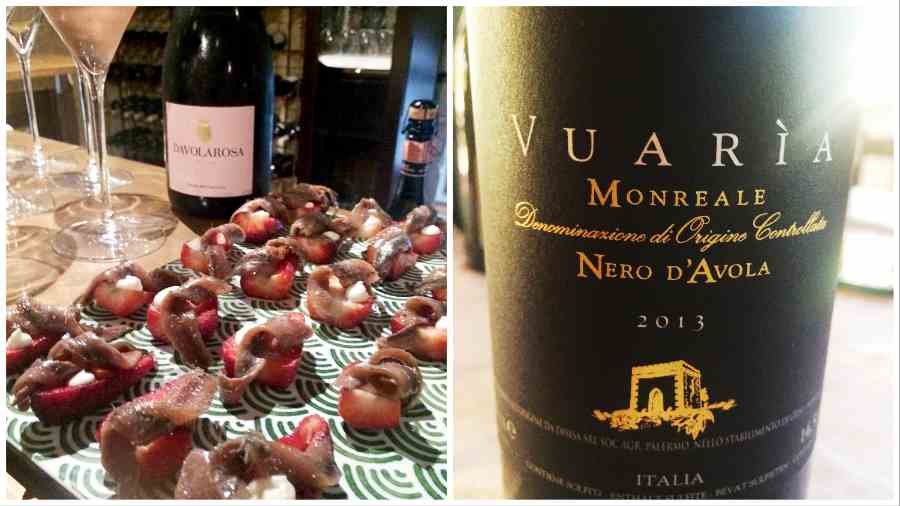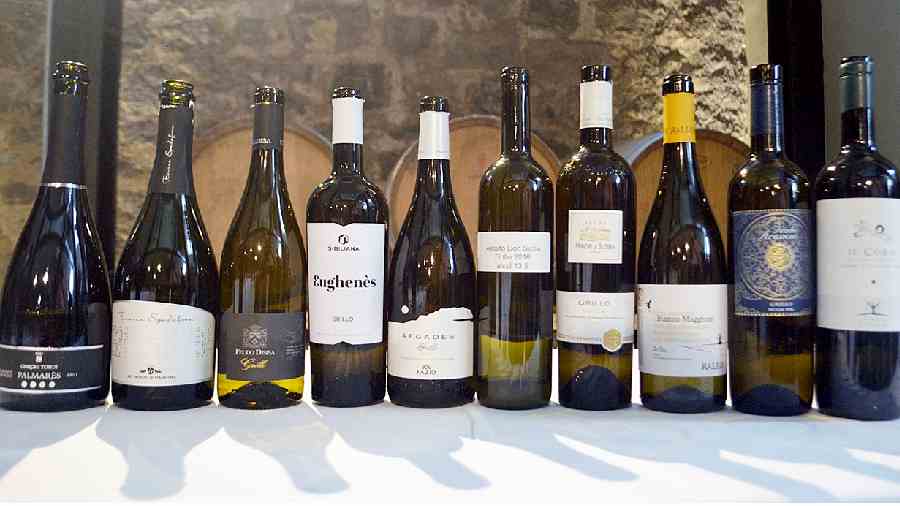I have been following the Sicilian wine vintage for a number of years, and so had the opportunity to visit almost the entire island — from the volcanic slopes of Mount Etna to the salt pans of Trapani to the olive groves in Monreale.
Sicily is the largest and most populous island in the Mediterranean. It is beautiful and rugged, from sandy beaches to Greek ruins, from hiking trails to mediaeval towns, from fabulous seafood to great wines. Since this article is focused mainly on the autochthonous grape varieties of Sicily and the wines they create, we should know a little bit about the 2022 harvest.
The 2022 harvest in Sicily was a 100-day affair starting August 1 in Trapani on the western shore, and ending in the first week of November on Mount Etna. The vintage, though warm, is expected to be an excellent one, thanks to the healthy grapes and near-perfect acid-sugar balance. There is evidence of great quality and freshness in white grapes and structure in red ones, though the quantity is expected to be slightly less than the previous year.
Sicily’s reputation as a wine region had been rather dodgy in the past, but since the 1990s the island is witnessing a renaissance in wine production and many winemakers are adopting modern techniques and crafting a myriad palette of wines, more so from indigenous varieties.
WHITE GRAPES
White grapes make up nearly two-thirds of vineyard plantings and are the backbone of the industry on the island. Here are the primary white grapes.
CARRICANTE
Carricante thrives on the slopes of Mount Etna where it is used for the production of Etna Bianco wines along with Catarratto and Minella. Being a late-ripening grape, it is often planted at higher altitudes on albarello vines, helping it to retain warmth from the volcanic soils. Wines made from this grape show a wide spectrum of colours, ranging from light straw to deep yellow depending on bottle age. They have aromas of citrus fruits, orange blossom, fresh herbs and aniseed. With bottle age this wine acquires greater complexity with aromas of flint, petrol and minerals. Many Etna producers make very good quality Etna Bianco, but perhaps none better than Pietra Marina from Benanti.
CATARRATTO
The most widely planted Sicilian grape, Catarratto, is intensively cultivated in the provinces of Trapani, Palermo and Agrigento, while being present in all other provinces as well, particularly in Etna where it is the secondary grape in the blend of Etna Bianco wines. It is also used in the production of Marsala.
The wine is straw yellow in colour with some greenish reflection. Aromas range from floral to white fruits. Being rather neutral in taste, it is more used as a blend.
GRILLO
Historically, Grillo had been planted in the province of Trapani as it used to be a blend in the making of Marsala wine. A cross between Catarratto and Zibibi, the grape has found a new lease of life in the last 30-odd years. Many forward-thinking winemakers realised the mono-varietal characteristics of the grape. Hence, today, Grillo is present in the provinces of Agrigento, Palermo, Caltanissetta, Siracusa — practically the entire island.
The wine is a strong yellow in colour. Aromatics are intense with notes of citrus, grapefruit, ripe guava and pomelo. Floral notes such as jasmine and mogra are also present. On the palate, the flavours are rich and structured, accompanied by crunching acidity and a savoury and persistent finish. This wine is an excellent accompaniment to shellfish, sushi, frito misto, tempura or pakoras.
There are many excellent examples of Grillo available, but a few that I’ve particularly liked are Grillo-Feudo Disisa, Grillo-Principi di Butera, Grillo Zagra-Valle d’Acate and Grillo Friends & Family-Feudo Maccari. Grillo could be the perfect answer to New World Sauvignon Blanc, sweeping the palates of young consumers the world over.
INSOLIA
Also called Ansonica, Insolia is another widely planted grape. it is not only found throughout Sicily but also in Calabria, the Tuscan islands as well as Sardinia. The grape is used in various appellations and IGT wines. It is pale yellow in colour with aromas of tropical fruits and citrus fruits, though not particularly intense. On the palate, it shows good balance of alcohol and acidity with a medium structure and finish.
A few other notables are Damaschino that is used in the blend for Marsala, Grecanico, Malvasia di Lipari that is used for making both sweet and dry wines on the island of Lipari and Moscato Bianco.
RED GRAPES
Though red grapes make up only one-third of vineyard plantings in Sicily, yet winemakers embrace them dearly, fashioning them into some breathtaking wines.
FRAPPATO
Not widely cultivated, Frappato is predominant in the regions of Siracusa and Ragusa, where, along with Nero d’Avola, it is used to make Sicily’s only DOCG wine, Cerasulo di Vittoria, an elegant wine where Nero d’Avola lends the structure and Frappato the floral notes and the finesse. Elsewhere, Frappato is less seen as a monovarietal.
The wine is deep ruby coloured with plenty of floral aromas and herb notes. The palate is well-structured with red berry notes and medium acidity along with moderate tannins.
NERELLO MASCALESE
This dark-skinned, highly regarded native grape growing on the volcanic slopes of Mount Etna has given the wines of Etna worldwide acclaim. Together with Nerello Capuccio it forms the basis of Etna Rosso DOC. The wines of Etna have caught the attention of wine critics, sommeliers and collectors over the last two decades or so. I would not have known about the wines had it not been for Giuseppe Benanti, who I first met more than 15 years ago (sadly he passed away recently) and whose tutelage will be forever cherished. In our numerous meetings he told me about his philosophy, approach to winemaking and guided me to appreciate the wines of Etna.
On the mineral-rich volcanic slopes, Nerello Mascalese grows on the traditional bush vine albarello method, sometimes as high up as 1,200m, much like Carricante, to absorb the warmth of the soil and to protect the vines from the strong rays of the sun and the wind. Growing on the soil, Nerello Mascalese gives the wines immense depth and complexity with huge ageing potential.
The wines are usually light to medium ruby coloured with aromas of strawberries, violets, dried flowers and liquorice. On the palate, one finds tobacco, truffle, lots of red fruits, good acidity and an excellent finish. I’ve often found the wines of Nerello Mascalese to be similar in taste to Nebbiolo wines of Barolo and Barbaresco as well as Pinot Noir of Burgundy. A recent DNA test has shown that Nerello Mascalese is a cross between Sangiovese and Mantonico Bianco.

(L-R) Insolia wines; The author with wine expert Giuseppe Benanti

(L-R) Appetisers that pair with Sicilian wines, Nero d’Avola wine
Many excellent Etna Rosso wines are available, a few are Serra della Contessa- Benanti, Rovittello-Benanti, Etna Rosso-Graci, Etna Rosso Arcuria-Graci, Feudo di Mezzo-Girolamo Russo, San Lorenzo-Girolamo Russo, Etna Rosso-Pietradolce, Etna Rosso Barbagalli-Pietradolce and Etna Rosso-Tornatore.
NERO D’AVOLA
The most famous grape of Sicily, Nero d’Avola (the black one from Avola) is found throughout the island. Originally from the province of Siracusa and once infamous for being exported as a blending grape to mainland Italy and neighbouring France, Nero d’Avola has changed its image. Today it is the ubiquitous wine of Sicily, found in many DOC and IGT appellations. Its versatility is seen in its availability in every conceivable corner of the island from petrol pumps to Michelin-star restaurants and cutting-edge gastro pubs. From everyday quaffing wine to complex barrique-aged ones, winemakers are going through the entire spectrum. The best results, though, are found in warmer climates.
The wine is deep red to deep garnet in colour with notes of cherries and strawberries, ripe fruits and, sometimes, herbaceous. On the palate it has good acidity and structure with balanced alcohol and notes of spices and herbs. Most producers create two or more different levels of wine; one an easygoing light example and other more structured and complex. Many examples are found of which a few are Vrucara Nero d’Avola-Feudo Montoni, Rosso Nero d’Avola-Zisola, Sherazade Nero d’Avola-Donnafugata, Nerojbleo Nero d’Avola-Gulfi, Lamuri Nero d’Avola-Tasca, Vuaria Nero d’Avola-Feudo Disisa, Lu Patri Nero d’Avola-Cristo de Compobello and Tané Nero d’Avola-Valle dell’Acate
Other red grapes of lesser importance are Nerello Capuccio, used as a blend in Etna Rosso, Perricone and Nocera.
The wines of Sicily have certainly arrived on the world stage and people have started to take notice. Affordability, quality-to-price ratio and availability are all positive factors that will secure their long-term future and the wines of Sicily will find their way to the homes of every wine consumer.
In India, the availability of Sicilian wines is on the rise and many importers are seriously contemplating bringing newer varieties, giving the consumer a wide choice. Next time you buy your Sicilian wine, check out the grape and your enjoyment will be so much better.
Subhasis Ganguli is a senior hospitality and wine consultant
